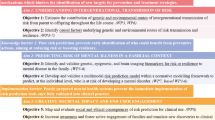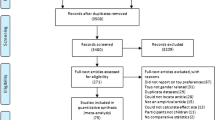Abstract
Correlations on scales of the Thurstone Temperament Schedule are examined in two twin studies (Michigan and Veterans twin samples), an adoption study (Texas), and an unpublished twin-family study. It is concluded that the joint evidence suggests (1) an appreciable effect of additive genes, differing across scales; (2) a negligible influence of shared environments, except possibly for monozygotic (MZ) twins; (3) a possible contrast effect among dizygotic (DZ) twins on temperament and personality traits, but shared interests; and (4) a causally ambiguous elevation of MZ twin correlations, which could be due either to nonadditive genetic effects or to a special sharing of environments (or self-concepts) in this group.
Similar content being viewed by others
References
Bouchard, T. J., Jr. (1984). Twins reared together and apart: What they tell us about human diversity. In Fox, S. W. (ed.),Individually and Determinism, Plenum, New York, pp. 147–178.
Cattell, R. B. (1966). The scree test for the number of factors.Multivar. Behav. Res. 1:245–276.
Davidon, W. C. (1975). Optimally conditioned optimization algorithms without line searches.Math. Program. 9:1–30.
Loehlin, J. C. (1965). A heredity-environment analysis of personality inventory data. In Vandenberg, S. G. (ed.),Methods and Goals in Human Behavior Genetics, Academic Press, New York, pp. 163–168.
Loehlin, J. C. (1985). Fitting heredity-environment models jointly to twin and adoption data from the California Psychological Inventory.Behav. Genet. 15:199–221.
Loehlin, J. C., Willerman, L., and Horn, J. M. (1985). Personality resemblances in adoptive families when the children are late-adolescent or adult.J. Personal. Soc. Psychol. 48:376–392.
Lykken, D. T. (1982). Research with twins: The concept of emergenesis.Psychophysiology 19:361–373.
McGue, M., Wette, R., and Rao, D. C. (1984). Evaluation of statistical methods of path analysis through computer simulation.Behav. Genet. 14:609–610 (abstr.).
Plomin, R., DeFries, J. C., and Loehlin, J. C. (1977). Genotype-environment interaction and correlation in the analysis of human behavior.Psychol. Bull. 84:309–322.
Rahe, R. H., Hervig, L., and Rosenman, R. H. (1978). Heritability of Type A behavior.Psychosom. Med. 40:478–486.
Rao, D. C., Morton, N. E., Elston, R. C., and Yee, S. (1977). Causal analysis of academic performance.Behav. Genet. 7:147–159.
Rosenman, R. H., Rahe, R. H., Borhani, N. O., and Feinleib, M. (1976). Heritability of personality and behavior pattern.Acta Genet. Med. Gemellol. 25:221–224.
Thurstone, L. L. (1953).Examiner Manual for the Thurstone Temperament Schedule (2nd ed.), Science Research Associates, Chicago.
Vandenberg, S. G. (1962). The Hereditary Abilities Study: Hereditary components in a psychological test battery.Am. J. Hum. Genet. 14:220–237.
Author information
Authors and Affiliations
Additional information
This work was supported in part by Grant BNS-7902918 from the National Science Foundation.
Rights and permissions
About this article
Cite this article
Loehlin, J.C. Heredity, environment, and the Thurstone Temperament Schedule. Behav Genet 16, 61–73 (1986). https://doi.org/10.1007/BF01065479
Issue Date:
DOI: https://doi.org/10.1007/BF01065479




